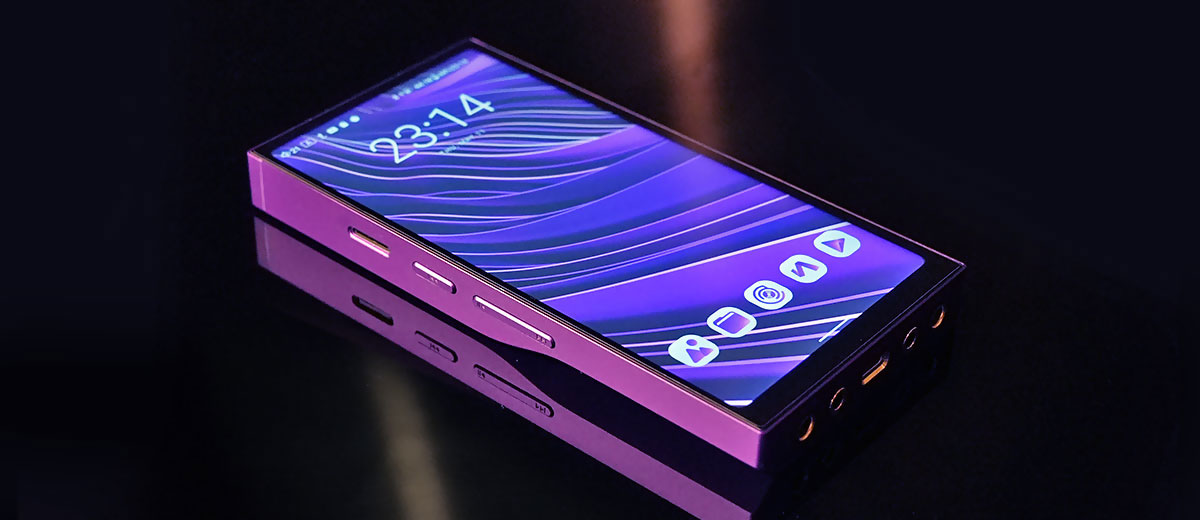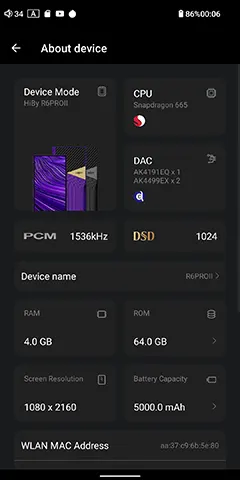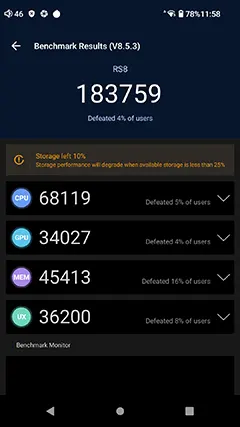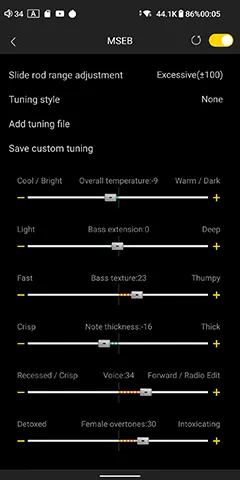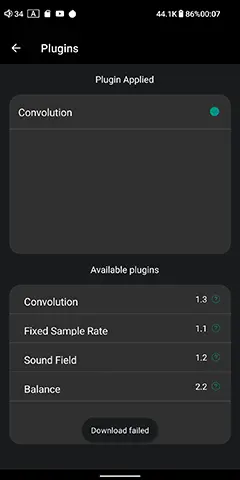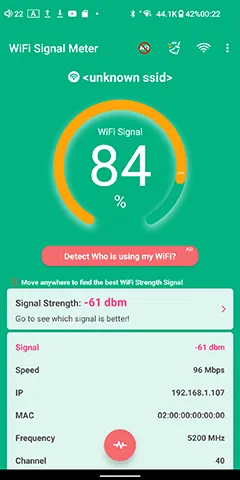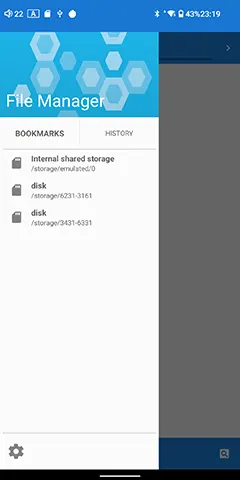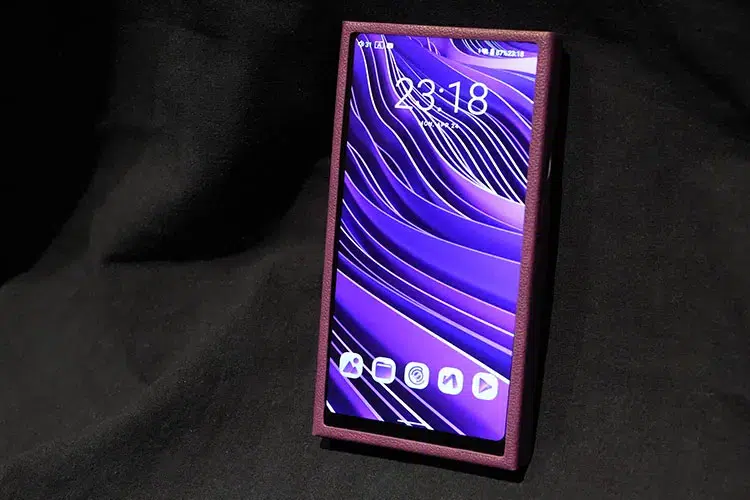Software
The R6 Pro II again, uses the same Snapdragon 660 SoC with 8-core clocked at 1.8GHZ as featured on their flagship DAP RS8, or the R6 III. The SoC supports BT5.0 and there is 64GB ROM and 4GB LPDDR4x-1866 RAM onboard, which is sufficient for minigames and multi-tasking.
Android 12
With the powerful Snapdragon 665 SoC, the R6 Pro II can easily support Android 12, which is beautifully customized specifically for this model. Not only does it bypass the SRC limitations to enable systemwide bit-perfect decoding, but the visuals are also deeply customized to touch up the user experience.
While some competition is still running Android 10 or lower, HiBy keeps pushing to adapt more updated software and advanced features. The high processing speed allows better flexibility with DSP as well, such as the inbuilt MSEB function that I always recommend.
Performance Numbers
With the same controller as the RS8, the R6 PRO II achieves an impressive performance score of 164065 on AnTuTu Benchmark v8.5.3. While the CPU score is only slightly lower than that of the RS8, the main difference between the headline scores is due to the R6 Pro II’s lower 4GB RAM performance.
Despite this, the RAM is still adequate for running multiple background apps while browsing with multiple tabs.
Features
MSEB & Tuning Plugins
One of the best features on board except Class A/AB switch is the HiBy Music app MSEB tuning function. This is a fun and intuitive equalizer function that has its toggles labeled in layman’s terms, which can be applied globally to the output of all apps.
You can access the MSEB function in settings and by dragging the bars inside you can very easily tune earphones to your own preferences.
Aside from MSEB, there is also a more advanced plugin feature that includes Convolution, Fixed Sample Rate, Sound Field as well as Balance features. You can load sample files to the convolver to mimic other IEMs and select their intensity, and the other options are pretty much self-explanatory.
All these DSP features allow the R6 PRO II to be much more versatile in its sound signature as well as the actual perceived performance.
Media Management
With the fast 665 SoC inside the R6 PRO II scans through the card very fast and smoothly, and you can slide across a long list of album cover art without delays. In HiBy’s own player app, you can always retrieve lyrics online which is quite a plus if you like to sing along.
The overall media, sound features, connectivity, and UI experience are again, very complete on HiBy’s deeply customized Android 12 OS.
Wireless Connectivity
Bluetooth 5.0
The R6 Pro II supports a bidirectional Bluetooth connection, allowing users to use it as a transmitter or a receiver just like a Bluetooth Dac Amp.
The design has further improved the stability and reliability of Bluetooth connection, and it supports multiple Codecs such as SBC, aptX-HD, and LDAC for high-quality audio transmission.
When tested at a distance of 4 meters against the FiiO BTA30 Pro receiver with an antenna, the R6 PRO II achieves a similar outstanding rating on the Bluetooth strength meter, ensuring seamless transmission across a spacious living room.
Moreover, testing with the final ZE8000 TWS demonstrated decent stability during train rides, maintaining an uninterrupted connection even in crowded areas.
WiFi
The R6 Pro II supports Airplay, DLNA, and HiByLink control via phones as well as HiByCast, which allows users to remote control the DAP from a phone or tablet.
That includes not only the inbuilt music app but other apps and settings as well. This is a fairly comprehensive and smooth experience for those who want to integrate the DAP as their HiFi system source or just to put it in the bag/pocket and navigate it from the phone.
Furthermore, the Wi-Fi signal strength is quite satisfactory, indicating over 95% signal strength when connected to my Linksys AX1800 Wi-Fi 6 router located a few meters away, even when obstructed by walls the signal strength still reaches 80%, and the connection remains stable.
High-quality videos on YouTube load without any delay or stuttering, and the download speed is exceptional. In addition, web browsing is seamless and matches the swift performance of the system.
Wired Connectivity
USB-DAC
The R6 PRO II supports being your PC’s Decoder so you can enjoy everything you stream, or even mix or play games while enjoying premium sound quality. There is no need to install any drivers but to utilize the full decoding power you may need to download some legacy ASIO drivers.
USB-OTG
Just like your phone, the R6 Pro II supports OTG, including but not limited to USB dongles. You can also use the R6 Pro II to connect to card readers for photo viewing or to hook up to other USB devices.
Sound Impressions
Summary
This is the first time I have put my hands on the 2+1 DAC architecture section and the output power rating is more conservative, so I am not sure what to expect.
Testing with a few IEMs of different impedance I can quite confirm that the R6 Pro II is not power lacking, it can open up IEMs with low to mid gain to sound firm, and punchy in the bass, while there are good dynamics and definition for multi-BAs to sound energetic and well defined.
Vocals on the R6 Pro II are laid-back and nicely polished to kill off sharpness and the tuning has retained sufficient penetration power and air to not sound curtained.
At higher volumes, the advantage of using Class A amping is more obvious where Class AB mode may sound less delicate and controlled especially when using higher impedance IEMs which may drag down the bass response speed.
Timbre
After around 100+ hours of burn-in, I find the R6 Pro II slightly smoother. I found the out-of-the-box sound more unpolished in the upper mids.
The R6 Pro II happens to be quite punchy and dense in the mid-lows, an M-shaped tuning that brings forward vocal richness and outlines the upper vocal frequencies for better transparency. The lower part of the vocal is well-textured and there is a good sense of control, so it does well to handle complex rhythms.
Class AB mode feels less colored and smoother as the lower mids are not as full, it is more prominent at a higher volume or with sensitive multi-BAs. The vocal is swifter and sounds less as forwarded as in Class A mode, which works better if you want the output to be more relaxing and smoothened.
The Class A/AB switch is always fun to test on sensitive IEMs to fit it to different music genres. You can switch between these settings from time to time to freshen up the listening experience, that way you may feel like playing with a new DAP.
Staging & Dynamics
The R6 Pro II sounds more spacious than expected given its power rating, and everything is naturally rendered without being pushed too forward or feeling recessed.
There is satisfactory separation though the vocal has a slightly fat image which I would sharpen with MSEB settings. Interestingly the vocal image is firmer on 3.5mm output than on 4.4mm output, which sounds more spread out.
The bass is slightly elevated which enhances the dynamics. The upper mids emphasize the treble transients but without overly pushing them, putting together a good balance between resolution and dynamics.
Click on page 3 below for pairings and our selected comparisons.

